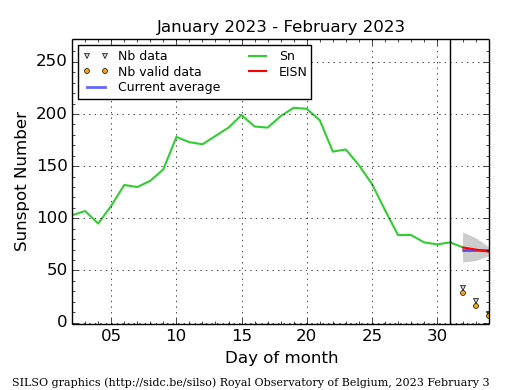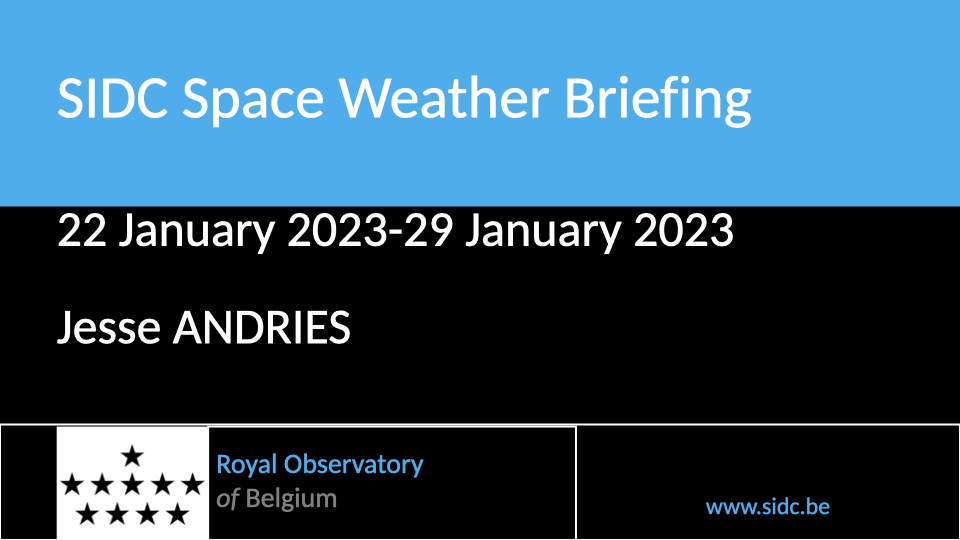- Table of Content
- 1.Review of sola...
- 2.Review of geom...
- 3.PROBA2 Observa...
- 4.The Internatio...
- 5.Noticeable Sol...
- 6.Geomagnetic Ob...
- 7.The SIDC Space...
- 8.Activity calen...
2. Review of geomagnetic activity
3. PROBA2 Observations (23 Jan 2023 - 29 Jan 2023)
4. The International Sunspot Index by SILSO
5. Noticeable Solar Events (23 Jan 2023 - 29 Jan 2023)
6. Geomagnetic Observations in Belgium (23 Jan 2023 - 29 Jan 2023)
7. The SIDC Space Weather Briefing
8. Activity calendar
Review of solar activity
Solar flaring activity was at low to moderate levels. The largest flare was a M4.6 flare on January 25, associated with NOAA AR3190. This region produced two other M-class flares in the first half of the week. Moderate flaring activity was also produced by NOAA AR 3194 and 3192 during the first half of the week. From January 27, the solar flaring activity reduced to low levels as the more complex regions had rotated off the solar disk leaving only relatively small simple regions.
Solar wind disturbances: coronale holes
Two small coronal holes transited the central meridian over the week. The first was a positive polarity coronal hole on January 24 and the second was a negative polarity on January 28.
Solar wind disturbances: coronal mass ejections
No Earth-directed coronal mass ejections (CMEs) were detected in the available coronagraph imagery over the past 24 hours.
Energetic particles near Earth
The greater than 10 MeV proton flux was at nominal levels. The greater than 2 MeV electron flux has been below the 1000 pfu threshold. The 24h electron fluence was at nominal levels.
Review of geomagnetic activity
On January 23, a transient magnetic feature was seen in the interplanetary magnetic field, where the magnetic field increased from 5 to 10 nT. The feature is possibly related to a glancing blow from a CME that left the sun on January 20. On January 26, the solar wind parameters indicated a mild high-speed stream reaching 590 km/s, before starting to gradually decrease on January 29 to values around 450 km/s. The interplanetary magnetic field was directed away from the Sun.
The geomagnetic conditions were quiet to unsettled throughout the week.
PROBA2 Observations (23 Jan 2023 - 29 Jan 2023)
Solar Activity
Solar flare activity fluctuated from low to moderate during the week.
In order to view the activity of this week in more detail, we suggest to go to the following website from which all the daily (normal and difference) movies can be accessed: https://proba2.oma.be/ssa
This page also lists the recorded flaring events.
A weekly overview movie (SWAP week 670) can be found here: https://proba2.sidc.be/swap/data/mpg/movies/weekly_movies/weekly_movie_2023_01_23.mp4.
Details about some of this week's events can be found further below.
If any of the linked movies are unavailable they can be found in the P2SC movie repository here: https://proba2.oma.be/swap/data/mpg/movies/.
Wednesday January 25


The largest flare of the week, an M4.6 flare, was observed by LYRA (top panel) and SWAP (bottom panel). The flare occurred on 2023-Jan-25 (peak at 10:11 UT) on the western limb, and it was associated with NOAA AR3190.
Find a SWAP movie of the event here: https://proba2.sidc.be/swap/movies/20230125_swap_movie.mp4.
The International Sunspot Index by SILSO

The daily Estimated International Sunspot Number (EISN, red curve with shaded error) derived by a simplified method from real-time data from the worldwide SILSO network. It extends the official Sunspot Number from the full processing of the preceding month (green line), a few days more than one solar rotation. The horizontal blue line shows the current monthly average. The yellow dots give the number of stations that provided valid data. Valid data are used to calculate the EISN. The triangle gives the number of stations providing data. When a triangle and a yellow dot coincide, it means that all the data is used to calculate the EISN of that day.
Noticeable Solar Events (23 Jan 2023 - 29 Jan 2023)
| DAY | BEGIN | MAX | END | LOC | XRAY | OP | 10CM | TYPE | Cat | NOAA |
| 25 | 0937 | 1011 | 1049 | N13W78 | M4.6 | SF | 48 | 3190 | ||
| 25 | 1642 | 1701 | 1713 | N17W77 | M1.3 | SF | 48 | 3190 | ||
| 25 | 2223 | 2235 | 2244 | M2.0 | 49 | 3192 | ||||
| 26 | 1253 | 1306 | 1315 | M2.8 | 3192 |
| LOC: approximate heliographic location | TYPE: radio burst type |
| XRAY: X-ray flare class | Cat: Catania sunspot group number |
| OP: optical flare class | NOAA: NOAA active region number |
| 10CM: peak 10 cm radio flux |
Geomagnetic Observations in Belgium (23 Jan 2023 - 29 Jan 2023)

Local K-type magnetic activity index for Belgium based on data from Dourbes (DOU) and Manhay (MAB). Comparing the data from both measurement stations allows to reliably remove outliers from the magnetic data. At the same time the operational service availability is improved: whenever data from one observatory is not available, the single-station index obtained from the other can be used as a fallback system.
Both the two-station index and the single station indices are available here: http://ionosphere.meteo.be/geomagnetism/K_BEL/
The SIDC Space Weather Briefing
The Space Weather Briefing presented by the forecaster on duty from January 23 to 29. It reflects in images and graphs what is written in the Solar and Geomagnetic Activity report: https://www.stce.be/briefings/20230130_SWbriefing.pdf

If you need to access the movies, contact us: stce_coordination at stce.be
Activity calendar
Check out our activity calendar: activities and encounters with the Sun-Space-Earth system and Space Weather as the main theme. We provide occasions to get submerged in our world through educational, informative and instructive activities.
If you want your event in our calendar, contact us: stce_coordination at stce.be
* January 30, 31, February 2, 3, Space Weather Introductory Course - online, by the STCE, zoom
* January 31, CmPA Seminar: Torsional Alfvén waves can trigger turbulence in nonuniform coronal loops, Leuven, Belgium
* February 2, STCE seminar: Bursts and bombs in the solar atmosphere, Brussels, Belgium
* February 17, STCE seminar: Point spread function corrections in solar physics, Brussels, Belgium
* March 14, PITHIA-NRF High Profile Meeting, Brussels, Belgium
* March 15, PITHIA-NRF Innovation Day, Brussels, Belgium
* March 16, PITHIA-NRF Training for Partners, Brussels, Belgium
* March 17, PITHIA-NRF Workshop for Optimization of Observational Strategies, Brussels, Belgium
* March 27-29, Space Weather Introductory Course - onsite, by the STCE, Brussels, Belgium - FULL
* May 22-24, Space Weather Introductory Course - onsite, by the STCE, Brussels, Belgium - FULL
* May 29 - June 1, PITHIA-NRF Training School, Rome, Italy
Check: https://www.stce.be/calendar
